Albania - Montenegro - Croatia - Bosnia - Slovenia - Venice
September 4 - 17, 2021
Flags of the Countries Visited
My tour through Albania, Montenegro, Croatia, Slovenia, and Venice will go down as one of the best vacations I have ever taken. I got an excellent dose of history, nature, and culture while experiencing interesting sights, amazing scenery, decent weather, friendly people, great food, and comfortable accommodations.
This trip was originally planned for May 2020 but postponed 1-1/2 years because of the COVID-19 pandemic. I spent 12 days on Gate1Travel's classic tour of Albania, Montenegro, Croatia and Slovenia followed by two days in Venice, Italy before jetting down to Palermo to catch Gate1Travel's 8-day Classic Sicily tour.
This blog will focus on just the 12-day tour of Albania, Montenegro, Croatia, Slovenia, and Venice. The blog for the Sicily can be found here.
When Did You Go? Where Did You Go? Fourteen days from September 4-17, 2021. I spent:
- 1 day traveling to Europe from my home in Milwaukee, Wisconsin, USA
- 2 days in Albania: Tirane, Kruja and Shkoder
- 3 days traveling through Montenegro: Kolasin, Dumitor National Park, Cetinje, Kotor
- 3-1/2 days traveling through Croatia: Dubrovnik, Split, Trogir & Zagreb
- 2-1/2 days traveling through Slovenia: Lake Bled, Ljubljana, Radovljica
- 2 days in Venice before flying to Sicily for a second escorted tour
I enjoyed all the sites but was most impressed with (in order) Dubrovnik, Lake Bled, (tie) Zagreb and Ljubljana, Split, and Kotor.
Did You Do This on Your Own or with a Tour Company? As mentioned above, I took an escorted tour with Gate1Travel through Albania, Montenegro, Croatia and Slovenia. I then guided myself through Venice, Italy. I've traveled with Gate1Travel at least a dozen times in the past. It is an excellent option if tours are your thing. Always great value for the money. Their tours are nicely paced, hit all the major sites, use excellent guides, and feature excellent accommodations and meals. I always load up on the optional excursions because they make every trip unique and special. This tour was no exception.
 |
| Our Tour Manager Bine (L) and Bus Driver Mario |
My tour group had 35 people, all from the US. Most were seasoned travelers. We got along well and my list of Facebook friends grew larger.
 |
The Men in My Tour Group with Our Tour Manager and Driver
|
 |
| The Women in My Tour Group |
How Did You Get There and Back? I traveled about 11,000 miles by plane and about 1,000 by motorcoach over the 14-day trip. I flew from the USA to Tirane, Albania via Frankfurt, Germany. Once on the ground, the tour group took a leisurely motorcoach drive from Tirane to Venice with numerous stops in Albania, Montenegro, Croatia and Slovenia. At the end of the tour, the group was dropped off in Venice for their flights home or next destination. I stayed in Venice for a few days, then flew to Palermo, Italy for my next tour.
Was It Easy Navigating Your Way Around? Yes, because we were situated either in the heart of town within walking distance to most everything, or shuttled by motorcoach to each destination.
Where Did You Stay? We stayed in a number of 4-, and 5-star hotels. Most were in or close to the center of town. All hotels and resorts were modern, clean and comfortable, with excellent, full-service restaurants and great Internet. The only negative was that fitness centers and pools opened around eight o'clock each morning such that I could not get the exercise I needed. I brought my running gear so was able to get out and run a few mornings.
 |
| Our 4- and 5-Star Hotels in Albania, Montenegro, Croatia & Slovenia |
The electricity situation was identical in all countries (230V, 50Hz). If coming from the US, you'll need a voltage adapter to avoid burning out your device if it doesn't already operate at a higher current level. You'll also need plug adapters to fit the round-peg outlets.
 |
| Plug Types Needed |
What Was the Food Like? Most of our meals were included in the price of the tour. Each hotel offered an excellent American and Continental breakfast buffet. And when we had group dinners at the hotel, we feasted on traditional local dishes and bottomless glasses of wine. Otherwise, we found pretty much any type of food we wanted, but I focused on traditional local dishes that would be hard to find in the USA.
How Were the People? My group was the first Gate1 group post-COVID. The locals were overjoyed to see us. Although I didn't know any of the local languages, most of the people we interacted with spoke English.
How was the Weather? The weather was nice most of the time although the days were somewhat warmer than expected (mid to upper 80s F with humidity). Fortunately, the nights were still cool. It never rained during the day.
What was the Time Difference? Albania, Montenegro, Croatia, Slovenia and Venice are all on Central European Time (GMT/UTC +01:00), which is 7 hours ahead of US Central Time (GMT/UTC −06:00).
What Was the Currency? What Were Prices Like? We dealt with several currencies: Albanian Lek, Croatian Kuna, and the Euro in Montenegro, Slovenia and Italy. The cheapest money exchange is at a bank ATM, which can be found everywhere. I got some Croatian Kunas and Euros for Slovenia and Italy, but no Albanian Leks given our short time there.
 |
| Currencies Used - Euros, Leks & Kunas |
What Did This Whole Trip Cost You? It was neither cheap nor expensive. I spent $4,204, or $300 per day on average. It was money well spent and an excellent travel value. I paid most of the trip cost in advance ($3,744), mostly the tour cost and airfare. Once on the ground, I spent another $460 on hotels, sightseeing, meals and tips, not included in the tour price.
Special Trip Considerations.
- COVID-19 Precautions. Proof of COVID vaccination was a precondition to travel and masking was required on planes and every indoor venue we encountered. A negative COVID test taken within 72 hours of entering Italy and the US was also required. The CDC COVID vaccination card was sufficient proof of inoculation and a doctor's written or emailed letter showing a negative test result was also accepted. Gate1 arranged for a doctor to come to our hotel and do swab tests as needed, but the cost was on us ($20-$25). Certified results were emailed to us within a few hours and a hard copy of the certificate could be picked up or printed at the hotel front desk.
- Air Quality. Air quality was generally fine everywhere we went. But I noticed that many cars still burn leaded gas, producing noxious car exhaust that can irritate the throat. If you have breathing issues, you may want to consider some sort of protection.
- Physical Condition. Some group members commented that they wished they were in better shape because many of our tours included arduous hikes up and over steep inclines and uneven surfaces in usually high heat and humidity. The tour company provided ample warning of such conditions but many still underestimated their physical abilities.
Any Parting Comments? Yes. Travel is an adventure. It’s an opportunity to experience, learn and appreciate how people around the world live. While I’m always happy to come home at the end, I never come back the same person.
Following is a day-by-day account of my trip. Each day starts with an overview of what we did, followed by my daily journal. You can just read on or go back to the Table of Contents above and jump to a specific day or topic of interest.
Enjoy!
Itinerary: Fly Chicago, USA to Tirana, Albania
Daily Journal
Weather: 73F and overcast.
After an 18-month delay, the long-awaited trip to Albania, Montenegro, Croatia, Slovenia and Venice finally arrived.
I took the morning CoachUSA bus from Milwaukee to O'Hare International (Chicago) to catch my 8-1/2 hour flight to Frankfurt, Germany. I arrived late morning at O'Hare, checked into my 4:00 pm flight, and relaxed for a few hours.
 |
| My Lufthansa 747-400 to Germany |
I boarded my Lufthansa 747-8 around 3:30 pm and departed on time at 4:00 pm. The plane was about half full so was quite comfortable all the way to Germany.
 |
| Our Route From Chicago to Germany |
I was presented with a European N95 medical mask upon boarding. Apparently, the cloth mask I was wearing was not good enough. At least the new mask did not fog up my reading glasses.
 |
| My European COVID Mask - Can Hardly Breath |
We had dinner during the first hour of the flight. Afterward, I took a melatonin tablet, donned my earplugs and eye mask, and slept for a couple of hours so that I would not be too jet-lagged the next day.
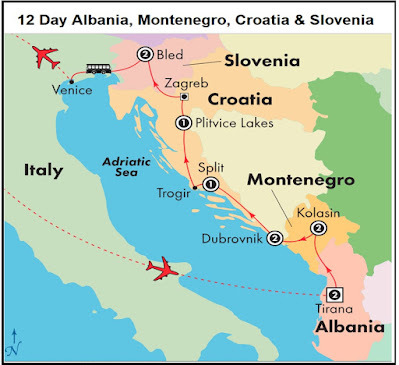 |
|
Itinerary: Arrive in Tirana, capital of Albania and center of the political, economic and cultural life of the country. Balance of day at leisure. Orientation meeting in the evening with tour manager and travel companions to learn about the journey ahead followed by dinner.
About Albania from Lonely Planet
Albania was closed to outsiders for much of the 20th century. But, with the end of a particularly brutal strain of communism in 1991, Albania's stunning mountain scenery, half-forgotten ancient Greek and Roman sites, crumbling castles, boisterous capital and beautiful beaches rival any in the Mediterranean region. Albania's origins likely stem from a collection of indigenous, Indo-European-speaking tribes first described by the ancient Greeks in the 6th century BC.
Daily Journal
My transatlantic flight from the US arrived in Frankfurt, Germany on time at 7:00 am Central European Time, which was 7 hours ahead of Chicago. We had a 3-hour layover in Frankfurt before boarding our Lufthansa A321 for the 1-3/4 hour flight to Tirana, Albania. During the layover, we got an unscheduled tour of the airport resulting from four gate changes and one terminal change.
 |
| Early Morning Arrival in Frankfurt, Germany |
We arrived on time in Tirana at 2 pm local time. The view flying in was beautiful. We met the Gate1 representative and other tour group members in the arrival hall and were transferred by shuttle bus to our hotel in the heart of Tirana.
 |
| The View Coming into Tirana, Albania |
 |
| Arrival at Tirana Airport |
 |
| Arrival at Tirana Airport |
|
After checking in to our centrally-located hotel, we went for a walk down the main street (Dëshmorët e Kombit) to Mother Theresa Square and back. I was surprised at how modern Tirana was with wide boulevards, clean streets, and glass skyscrapers. Tirana reminded me a bit of Phoenix, Arizona because it lies in a valley surrounded by tall mountains. Unlike Phoenix, Tirana is close to water, situated on the Adriatic coast of the Mediterranean Sea east of the boot of Italy.
 |
| Our Hotel in Tirana - Hotel Rogner |
 |
| Dëshorët e Kombit Street |
 |
Dëshmorët e Kombit Street
|
|
|
 |
Mother Theresa Memorial
|
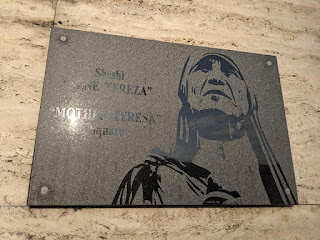 |
Mother Theresa Memorial
|
 |
| National Soccer Stadium |
 |
| National Soccer Stadium |
In the early evening, the tour group met our Slovenian tour manager, Bine Augustin, in a conference room at our hotel for a meet-and-greet and tour orientation. The tour group consisted of 35 people, which was about twice the size of a typical Gate1 group. The group was also the first Gate1 tour in the area following the COVID pandemic. After the orientation meeting, we had a welcome dinner at our hotel featuring local dishes. After that, it was time for bed after a long day of travel and an aggressive tour schedule the following day.
 |
| Gate1 Tour Schedule |
Itinerary: Morning tour featuring the highlights of Tirana followed by an afternoon tour of nearby Kruja.
About Tirana from Lonely Planet
Daily Journal
Weather: 80F and sunny.
I got up at 5:50 am and ran 5 miles through the area that we would see later on our morning tour. Jet lag was not an issue on this trip! My run was peaceful and quiet for the first half-hour, but after that, the traffic got heavier as people commuted to work. I recognized the foul odor of leaded gas exhaust so cut my run a little short to avoid any breathing problems.
By 7:30 am, I was having breakfast at the hotel restaurant, which included a bountiful buffet with enough variety to satisfy any taste.
At 8:30 am, we met our local guide, Nida, in the hotel lobby for a walking tour of Tirana. Colorful Tirana is the capital of Albania and where hopes and dreams coalesce into a vibrant whirl of traffic, brash consumerism and unfettered fun. Having undergone a transformation of extraordinary proportions since emerging from communism in the early 1990s, Tirana's center is now unrecognizable and a pleasure to wander. The city's history dates back to the Palaeolithic age, some 10,000 to 30,000 years ago. The city itself is relatively new, about 400 years old, founded in 1614 by a feudal lord from the region. Tirana's geographic location, between mountains and sea, in the very heart of Albania, has made this city very attractive to the Albanians, encouraging them to move here.
Albania has always been at the crossroads of war and trade so made friends and enemies at the same time. Before Albania existed, it was occupied by many countries and was eventually divided between Greece and Italy prior to gaining independence and becoming a freestanding country. Today, Albania has three million people with one million in Tirana. It is predominantly Muslim but not as strict on practice as other Islamic countries.
 |
| Group Gathering for the Tirana Tour |
 |
| Whisper Device for Touring |
 |
| Our Tour Leader Bine (L) and Local Guide Nida |
Our tour of Albania started at our hotel on the south end of the main street (Dëshmorët e Kombit, "Boulevard of the Martyrs") and went north to the Natural History Museum on Skanderbeg Square.
Along the way, we stopped at the Parliament building and the Soviet-built Palace of Culture with its first stone symbolically placed by Nikita Khrushchev.
 |
| Parliament Building |
 |
| Prime Minister's Office |
 |
| Prime Minister's Office |
 |
| Pyramid of Tirana Conference Center |
The next stop was the Tirana Library with its interesting "Cloud" monument in front. Behind the library were stored several statues of Russian and Albanian leaders from Albania's communist era (1940-1990). The statues included Lenin, Stalin, and Albania's former Communist leader, Enver Hoxha, who ruled with such an iron fist that Albania is often referred to as the "North Korea of Europe." The statues once graced public squares around Tirana, but are now stored here for lack of other space.
 |
| Tirana Library |
 |
| Tirana Library - "The Cloud" Sculpture |
 |
| Storage Space Behind Library - Old Communist Leaders |
After the Library, we passed through the city's main pedestrian street with numerous shade trees and cafes. We then came to colorful Theater Square featuring Bunk'Art 2, a museum created from an old bunker the Communist leaders planned to hide in during a hostile attack.
 |
| Theater Square |
 |
| The Group Walking through Theater Square |
 |
| Most Popular Pedestrian Area in Town |
 |
| Theater Square |
 |
| Theater Square |
 |
| Theater Square |
 |
| Theater Square - Former Bunker, Now a Museum |
 |
Theater Square - Former Bunker, Now a Museum
|
About an hour into the tour we reached Skanderbeg Square, the bustling heart of the city. The Square is named after Albania's most famous war hero. While there, we viewed Et'hem Bey Mosque, serving as a symbol of the rebirth of religious freedom in Albania, and the vast marble square.
After the Tirana tour, we boarded our bus and drove 15 miles north to the town of Kruja for lunch, followed by visits to a lively shopping bazaar, Kruja Castle, a wonderful ethnographic museum, and a local restaurant for dinner with panoramic views of the city.
We learned that Kruja is the birthplace of Gjergj Skanderbeg, who from 1444-66, repulsed 13 Turkish invasions and became a hero throughout the Western world. The tidy city with a historic center is nestled in a mountainside and home to numerous bars, restaurants and gift shops named after George W. Bush, arguably the most famous person ever to come here. When GWB was here, he shook hands with a large number of locals and was missing his watch when it was over. It's unclear whether the watch was stolen or lost, but GWB eventually got it back.
 |
| Kruja, Albania |
 |
| Kruja, Albania |
 |
| Kruja - Skanderbeg Statue |
Our visit started with lunch at the Panorama Hotel featuring sweeping views of the valley and mountains between Kruja and Tirana. In the distance, one can see Italy across the Adriatic Sea. Over a lunch featuring local Albanian fare, we were treated to a lively cultural dance show.
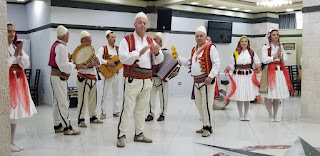 |
| Kruja - Traditional Albanian Dancers |
After lunch, we hiked through a colorful shopping bazaar on our way to Kruja Castle and the Ethnographic Museum perched high on the hilltop overlooking town.
 |
| Kruja - View toward Kruja Castle |
 |
| Kruja - Shopping Bazaar |
 |
| Kruja - Shopping Bazaar |
 |
| Kruja - Shopping Bazaar |
 |
| Kruja - Shopping Bazaar |
We climbed the long hill leading up to the castle and spent our time taking photos of the surrounding area and visiting an ethnographic museum inside the castle.
 |
| Kruja - View toward Kruja Castle |
 |
| Kruja - Kruja Castle |
 |
| Kruja - Kruja Castle |
 |
| Kruja - View from Kruja Castle |
 |
| Kruja - View from Kruja Castle |
 |
| Kruja - Kruja Castle |
 |
| Kruja - Kruja Castle |
 |
| Kruja - Kruja Castle |
The
National Ethnographic Museum in Kruja presents the story of Albanian customs and traditions throughout the centuries. Built during the mid-18th century, in 1764, by Ismail Pashë Toptani, this Ottoman house is considered one of the most unique museums in Albania. It includes 15 rooms that recount work and family life in the town of Kruja.
 |
| Kruja - Ethnographic Museum Inside Kruja Castle |
 |
| Kruja - Ethnographic Museum Inside Kruja Castle |
 |
| Kruja - Ethnographic Museum Inside Kruja Castle |
 |
| Kruja - Ethnographic Museum Inside Kruja Castle |
 |
| Kruja - Ethnographic Museum Inside Kruja Castle |
 |
| Kruja - Ethnographic Museum Inside Kruja Castle |
 |
| Kruja - Kruja Castle |
 |
| Kruja - Kruja Castle |
After touring the castle and museum, we walked back down to town and spent some time browsing the bazaar and the neighborhoods surrounding the old town center. During that time, we heard the call to prayer coming from loudspeakers at a local mosque and eventually found our way to the mosque where we observed men praying with lots of shoes outside the door.
 |
| Kruja - Shopping Bazaar & Mosque |
 |
| Kruja - Shoes Outside Mosque
|
 |
| Kruja - New Town |
 |
| Kruja - New Town |
 |
| Kruja - George W Bush Visit Left Impression on Town |
In the early evening, we went back to the Panorama Hotel where we had lunch and enjoyed a dinner featuring Albanian delicacies and phenomenal views of the surrounding region.
 |
| Kruja - Night View from Panorama Hotel |
Following dinner, we drove back to Tirana, arriving back at our hotel around 9 pm. Then it was straight to bed.
Itinerary: Travel from Tirana to Shkodra, Albania, an important cultural center and one of Albania's oldest cities. Cross the border into Montenegro, the jewel of the Mediterranean, nestled on the beautiful Adriatic coast with its lovely beaches and crystal-clear lakes. Afternoon visit to the impressive 13th-century Moraca Monastery, the largest medieval Orthodox monument in Montenegro. Late afternoon arrival in the spa town of Kolasin, situated in the thick pine forest of the Bjelasica Mountains with expansive views of the surrounding peaks.
Daily Journal
Weather: 83F and sunny.
The morning started with a sumptuous breakfast at the hotel restaurant.
At 8:30 am, we departed on the 140-mile drive to the town of Kolasin in central Montenegro, with a stop in Shkoder, Albania, and Moraca Monastery outside Kolasin along the way.
While driving through the Balkan mountains on our way to Shkoder, our local guide answered questions from the group. We learned that, from WW II to roughly 1991, Albania was ruled by a brutal Prime Minister named Enver Hoxha, a communist revolutionary who successfully defeated the Nazis during WW II and was regarded as a sort of hero. But that's where it ends. Following the war, and for the next 40 years, he consolidated power, closed the borders, spied on citizens, executed his enemies, and ruled with an iron fist until his death in 1985. His reputation earned Albania the title of the "North Korea of Europe." During his reign, he bugged the country and encouraged people to rat out their neighbors. He also built 170,000 bunkers around the country for use by the military. We saw some of these bunkers while touring Tirana and several more dotting the countryside. We also learned that Albania is 60% Muslim, but was largely Christian in its early history when the region was controlled by the Romans.
Around 11:00 am, we arrived in Skhoder, Albania for a short visit. Shkoder is one of the oldest cities in Europe and is considered the most attractive urban center in Albania. Over the next hoúr, we walked the town's pedestrian area. It was quite beautiful with all the colorful buildings, cafes, mosques and churches. The town is just reawakening after 18 months of COVID shutdown.
 |
| Shkodra, Albania - Pedestrian Zone |
 |
| Shkodra, Albania - Pedestrian Zone |
 |
| Shkodra, Albania - Pedestrian Zone |
 |
| Shkodra, Albania - Pedestrian Zone |
 |
| Shkodra, Albania - Pedestrian Zone |
 |
| Shkodra, Albania - Pedestrian Zone |
 |
| Shkodra, Albania - Pedestrian Zone |
 |
| Shkodra, Albania - Pedestrian Zone |
 |
| Shkodra, Albania - Pedestrian Zone |
 |
| Shkodra, Albania - Pedestrian Zone |
 |
| Shkodra, Albania - Pedestrian Zone - Pet Shop |
Around 1:40 pm, we reached the Albania-Montenegro border. We got a good view of Skhoder Lake while waiting to be processed over the border crossing. The lake forms the boundary between Albania and Montenegro and is 26 miles long and 9 miles wide. There are lots of birds because the lake is along the north-south migratory route. The mountains surrounding the lake were also quite picturesque.
Despite being only the size of Connecticut, Montenegro bursts at the seams with majestic mountains, breathtaking beaches and larger-than-life locals. Its coastline has some of Europe’s most spectacular seaside scenery with towns clinging to the mountains. Its history and culture are also rich and can be seen in the mosaic floors of Roman villas, flamboyantly painted Orthodox monasteries, ornate Catholic churches, elegant minarets of mosques, and sturdy fortresses built by the numerous powers that have fought over these lands.
After a few hours of driving through the mountains, we arrived at Moraca Monastery. The monastery was built in 1252 and is run by Orthodox monks. We toured the site for an hour before heading to our hotel in Kolasin.
Moraca Monastery has two churches with beautiful frescoes and a courtyard surrounded by high walls and is one of the most important Orthodox monasteries in Montenegro, with some of its most accomplished religious art. Moraca is an active monastery.
Its two churches are plastered in frescoes; the larger Church of the Dormition has external frescoes and beautiful doors inlaid with geometric patterns. As you enter the walled compound into a garden courtyard where the bees from the monks’ hives dance between the hydrangeas and roses, it’s like stepping back into the 13th century.
To the right, the smaller St Nicholas’ Church has faded frescoes on its facade which were once as vivid as those inside. One can still make out the Madonna and Child above the door and an archangel on either side.
In the vestibule of the Church of the Dormition, there’s a fascinating vision of Christ sitting in judgment, attended by saints. A slide of flames shoots the damned into hell where two-headed people-eating sea monsters do their worst and angels spearing little demons in the face to prevent them from tipping the scales of justice. The church's treasures include Mitrofanović's The Virgin Enthroned with Child, Prophets and Hymnographers (1617), which sits within the iconostasis, to the left of the sanctuary door. The other master at work here was Kozma, whose icon of Saints Sava and Simeon (1645), on the right-hand wall, includes a border showing the construction of the monastery. To the left is the icon of St Luke depicting the apostle painting an icon of the Madonna and Child.
 |
| Path to Moraca Monastery near Kolasin Montenegro |
 |
Moraca Monastery - Main Gate
|
 |
Moraca Monastery - Orthodox Monk
|
 |
| Moraca Monastery - Beehives |
 |
| Moraca Monastery - Inside Courtyard |
 |
| Moraca Monastery - St Nicholas’ Church |
 |
| Moraca Monastery - St Nicholas’ Church |
 |
| Moraca Monastery - St Nicholas’ Church |
 |
| Moraca Monastery - Church of the Dormition |
 |
| Moraca Monastery - Church of the Dormition |
 |
| Moraca Monastery - Church of the Dormition |
 |
| Moraca Monastery - Church of the Dormition |
 |
| Moraca Monastery - Church of the Dormition |
 |
| Moraca Monastery - Water Fountain |
 |
| Moraca Monastery - Courtyard |
 |
| Moraca Monastery - Courtyard |
 |
| Moraca Monastery - Courtyard |
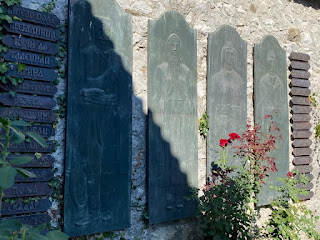 |
| Moraca Monastery - Courtyard |
Following the visit to Moraca Monastery, we drove 45 minutes north to our hotel in Kolasin. Kolasin sits 3,100 feet above sea level and is Montenegro’s main mountain resort. Like most ski towns, it looks far prettier under a blanket of snow, but even outside of winter, it’s a handy base for exploring the region. After checking in to our hotel, we had some time to explore the hotel and surrounding area on our own.
 |
| Kolasin, Montenegro |
At 7 pm, the group reconvened for a delicious Montenegro dinner at our hotel. Then it was off to bed.
Itinerary: Morning stop at Biogradsko, considered the most picturesque lake in the Balkan Peninsula with its serene and natural beauty followed by visit to breathtaking Durmitor National Park, a UNESCO World Heritage Site formed by glaciers and traversed by rivers and underground streams. Stop at Tara River Canyon, which has the deepest gorges in Europe, with dense pine forests interspersed with clear lakes and a wide range of endemic flora.
Daily Journal
Weather: 74F and partly sunny.
The morning started with a hearty breakfast at the hotel restaurant.
We left the hotel at 8:30 am for Biogradsko Gora (Lake Biograd), one of the most picturesque lakes in the Balkan Peninsula with its serene and natural beauty. We spent about 45 minutes at the lake walking the trails and enjoying the fresh air and scenery.
Around 10:30 am, we stopped at a scenic overlook for pictures of the Tara River Canyon, the second deepest canyon in the world next to the Grand Canyon.
 |
| Northern Montenegro - Tara River Canyon |
We then entered Durmitor National Park. The rugged and dramatic park is one of Montenegro’s showpieces. Carved out by glaciers and underground streams, Durmitor stuns with dizzying canyons, virgin forests, and glittering glacial lakes and nearly 50 limestone peaks soaring to over 6,000'. In winter, Durmitor is a major ski resort, while in summer it’s popular for hiking, rafting and other active pursuits. The national park covers the Durmitor mountain range and a narrow branch heading east along the Tara River towards Mojkovac. Durmitor is home to 163 bird species, about 50 types of mammals and purportedly the greatest variety of butterflies in Europe.
Once in the Durmitor National Park, we stopped at the Tara River Bridge to walk the span and take photos. I walked over the bridge and took the zip line back.
 |
| Northern Montenegro - Tara River Canyon |
 |
| Northern Montenegro - Tara River Canyon - View from Bridge |
 |
| Northern Montenegro - Tara River Canyon - Zipline Fun! |
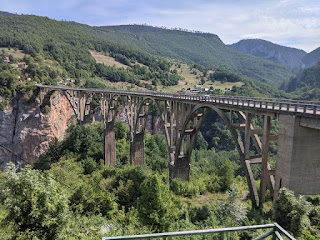 |
| Northern Montenegro - Tara River Canyon |
We then had lunch nearby at Hotel Enigma and feasted on Montenegro moussaka. The grazing cows outside the restaurant took an interest in what was going on inside and delighted the group by standing outside and looking in the windows.
 |
| Lunch Stop - Curious Free Range Cow |
After lunch, we went deep into Durmitor National Park and hiked to Black Lake. While there we took a group photo for Gate1 that will likely appear in a future brochure.
 |
| Montenegro - Durmitor National Park |
 |
| Montenegro - Durmitor National Park
|
 |
| Montenegro - Durmitor National Park
|
 |
| Montenegro - Durmitor National Park
|
 |
| Montenegro - Durmitor National Park |
 |
| Montenegro - Durmitor National Park |
 |
| Montenegro - Durmitor National Park |
 |
| Montenegro - Durmitor National Park |
 |
| Montenegro - Durmitor National Park |
Around 3:30 we headed back to our hotel in Kolasin. Upon arrival at 5:45 pm, I went for an 8-mile run up into the mountains surrounding Kolasin. The view was pretty nice.
 |
| Kolasin, Montenegro |
After two big meals today, I skipped dinner and went out to a local bar where our excellent Montenegro bartender took good care of us. The bar was a retro Yugoslavia bar with pictures of life in old Yugoslavia including photos of Tito and other famous Yugoslavians. Eventually, three women from our tour wandered into the same bar (Vexie, Marianna and Fernanda) and we spent another hour chatting and getting to know each other better. We also had a shot of Rakia, a distilled plum spirit that smelled a lot like tequila with an alcohol content of 40%. |
| (L to R) Joe, Vexy, Fernanda, Mariana & Yours Truly Out on the Town |
Eventually, we said goodbye to our bartenders Ilea and Ivan, and headed back to the hotel.
Itinerary: Travel to Podgorica, the cultural center of Montenegro, built amongst five rivers. As most of the city was destroyed during WW II, Podgorica is now completely rebuilt with modern buildings and many open green spaces. Continue to Cetinje at the foot of Mount Lovcen, a treasure of Montenegrin cultural and historical heritage, with its colorful architecture dating back to the 18th and 19th centuries. Visit the King Nicola’s Museum, a historical complex with four sections: history, art, ethnographic and archaeological. Then, drive along a steep road down to the fjord-like Bay of Kotor - the view is unforgettable. Along the way, see the spectacular scenery of the Dalmatian coast and jewel-like town of Kotor, a UNESCO World Heritage Site. Arrive in the spectacular walled city of Dubrovnik; see the astonishing views of the city known as the "Pearl of the Adriatic".
Daily Journal
Weather: 76F and cloudy.
After another good night of sleep and a hearty breakfast at the hotel restaurant, we boarded our bus at 8:30 am and headed toward our final destination of the day, Dubrovnik, Croatia. Along the way, we stopped in Cetinje to visit King Nicola’s Museum and the wonderful medieval walled city of Kotor.
After about an hour of driving through the mountainous terrain, we stopped at a gas station for a bathroom break. While there, a hungry feral kitten was meowing at me from the second four ledge of a building under construction next door. So I bought a can of tuna at the gas station convenience store and went up to the second floor of the building under construction to feed it.
We drove through but did not stop in the capital city of Podgorica on our way to the former capital city Cetinje. At 10 am, we stopped in Cetinje to tour the King Nicola History Museum. King Nicola was Montenegro's last king. The first floor was used for administrative purposes and the upstairs is where the king, queen and family lived. The king and queen had nine children and all married into other royal families from other countries. The museum contained artifacts from the time the family lived there.
 |
| Cetinje, Montenegro |
 |
| Cetinje Monastery |
 |
| Cetinje Monastery |
 |
| Cetinje - Joe Playing Tour Guide
|
|
 |
| Cetinje - King Nicola’s Museum |
 |
| Cetinje - King Nicola’s Museum |
 |
| Budva, Montenegro |
 |
| Budva, Montenegro |
 |
| Budva, Montenegro |
 |
| Adriatic Coast Between Budva and Kotor |
 |
| Adriatic Coast Between Budva and Kotor |
 |
| Adriatic Coast Between Budva and Kotor |
 |
| Adriatic Coast Between Budva and Kotor |
 |
| Adriatic Coast Between Budva and Kotor |
 |
| Adriatic Coast Between Budva and Kotor |
 |
| Adriatic Coast Between Budva and Kotor |
Our second stop what's the medieval town of Kotor. We were greeted in Kotor with a huge traffic jam which kept us trapped in a tunnel underground for 45 minutes. Eventually, we made it to the walled city of Kotor where we were dropped off and allowed to explore on our own for an hour. Spectacular.
 |
| Kotor - City Gate |
 |
| Kotor - Main Square |
 |
| Running Joke - Montenegrins Are Lazy |
 |
| Leaving Montenegro, Entering Croatia |
 |
| Gatting Close to Dubrovnik |
 |
| Gatting Close to Dubrovnik |
 |
| Getting Close to Dubrovnik |
Upon arrival, we stopped at a scenic overlook of Dubrovnik for photos. We then went to our hotel and checked in. This was the best room so far. It overlooked the ocean and the pool area.
 |
| Dubrovnik, Croatia |
While going down to dinner, we rode down the elevator with another couple from the US. They asked us where we'd come from that day and I honestly couldn't remember. We have been moving so expertly and seen so much I didn't even know it was Thursday.
After checking into the hotel at 7 pm, we went downstairs to enjoy a gigantic buffet dinner at the hotel's busy restaurant.
 |
| View from Dubrovnik Hotel Balcony |
After dinner, we toured the hotel facilities before returning to the room.
Itinerary: Tour of Dubrovnik. Dubrovnik stands as one of Europe's most beautifully preserved medieval cities, surrounded by ramparts, watchtowers, and the azure Adriatic Sea. Within its walls, explore a treasure trove of rich history. View the Rector's Palace and Franciscan Monastery, home to a 30,000-volume library and the 14th-century pharmacy that is the oldest still in function pharmacy in Europe. Admire the stunning views of the Old Town and the Adriatic when you walk along the city's fortress wall. This stroll around Dubrovnik's perimeter offers a breathtaking perspective of red-roofed stone buildings and ancient, narrow alleys. In the evening, enjoy a traditional Croatian dinner at a lovely homestead located a short drive from Dubrovnik in the Croatian countryside to enjoy tasty samplings such as local cheese and Dalmatian prosciutto. Take in the lush surroundings while savoring a traditional meal consisting of time-honored dishes, carefully prepared with fresh ingredients from the farm.
Croatia sits at the crossroads of Central and Southeast Europe and is about the size of West Virginia. The country began when the Croats arrived in the 6th century. In 1102, it merged with Hungary but was conquered by the Ottoman Empire in 1527. In 1918, it merged into the Kingdom of Yugoslavia. In April 1941, it was incorporated into a Nazi state as the Independent State of Croatia. A resistance movement led to the creation of the Socialist Republic of Croatia, which after WW II, became a founding member and constituent of the Socialist Federal Republic of Yugoslavia. On June 25, 1991, Croatia declared independence from Yugoslavia, and the War of Independence was fought for four years.
Today, if your Mediterranean fantasies feature balmy days by sapphire waters in the shade of ancient walled towns, Croatia is the place to turn them into reality. Croatia's extraordinary island-speckled coastline is indisputably its main attraction. The first thing that strikes you is the remarkable clarity of the water. And if there's an upside to its continual dislocation over the millennia, it's in the rich cultural legacy that each has left behind. Venetian palaces snuggle up to Napoleonic forts, Roman columns protrude from early Slavic churches, and Viennese mansions face-off with Socialist Realist sculpture. Excellent museums showcase treasures that cover the gamut of European history, from prehistoric to post-communist, telling a story that is in equal parts fascinating and horrifying. Shift your gaze for just a moment from the glittering waters and chances are an almighty mountain will loom into view. The Dinaric Range, which stretches all the way from Italy to Albania, hugs much of the coast. The limestone karst has bequeathed a wonderland of craggy peaks, caverns, river canyons, waterfalls and ridiculously picturesque lakes.
Dubrovnik is one of the most prominent tourist destinations in the Mediterranean Sea. The history of the city probably dates back to the 7th century, when the town known as Ragusa was founded by refugees from Epidaurus. It was under the protection of the Byzantine Empire and later under the sovereignty of the Republic of Venice. Between the 14th and 19th centuries, Dubrovnik ruled itself as a free state. The prosperity of the city was historically based on maritime trade. In the 15th and 16th centuries, it became notable for its wealth and skilled diplomacy. At the same time, Dubrovnik became a cradle of Croatian literature. Today, the beauty of Dubrovnik never fails to impress with its limestone streets, baroque buildings, ancient walls and the endless shimmer of the Adriatic Sea. It's no wonder Dubrovnik's old town is a UNESCO World Heritage site.
Daily Journal
We departed at 8:45 am for a morning tour of Old Town Dubrovnik, built in the 16th century.
We got dropped off at the Pile Gate, the main entrance to the walled city, where we met our local guide, Paro, and took a leisurely stroll through town admiring the architecture and beauty. We visited the oldest pharmacy in the world where we saw the corridor in which they filmed many segments of the Game of Thrones.
We then walk to the Rector's Palace. On the way, we saw the oldest graffiti in town. The graffiti on the wall of the church says "peace be with you. Don't play ball here."
 |
| Dubrovnik - View from Hotel Balcony |
 |
| Dubrovnik - Enjoying the Pool |
At 5:30 pm, we boarded our bus and ventured into the countryside for a traditional Croatian dinner at the home of a local family in nearby Orasac. The dinner started with a demonstration of the old-fashioned way to make olive oil. Pearl the horse showed how olives were crushed and the owner showed the pressing process. Today, all is made by machine. For dinner, we feasted on homemade grappa, bread, cheese, and homegrown vegetables. We also had beef and chicken skewers and bottomless glasses of red wine.
 |
| Orasac, Croatia - Farm Dinner |
 |
| Orasac, Croatia - Farm Dinner - Pearl Crushes Olives |
 |
| Orasac, Croatia - Farm Dinner - Owner Presses Olives for Oil |
 |
| Orasac, Croatia - Farm Dinner Group |
 |
| Orasac, Croatia - Farm Dinner Group |
 |
| Orasac, Croatia - Farm Dinner Group
|
 |
| Orasac, Croatia - Farm Dinner Appetizer |
 |
| Orasac, Croatia - Farm Dinner Main Course |
 |
| Orasac, Croatia - Farm Dinner Dessert |
We returned from dinner at 8:30 pm to pack our bags for the trip to Split tomorrow.
 |
|
Itinerary: Depart Dubrovnik and travel north along the dramatic Adriatic coast, past charming old fishing villages and brand-new resorts, to the UNESCO-protected seaside town of Split, the second largest city in Croatia. Upon arrival, take a walking tour along the cobbled streets of the Old Town featuring the historic inner city with its dominating Roman influence, built around the 4th century Palace of Diocletian. This spectacular palace is the largest and best-preserved building of the Roman era on the Adriatic coast. Built for Emperor Diocletian, it represents a precious example of Roman architecture. See the remains of the Roman Peristyle, the unusual Cathedral of St. Domnius built in the Middle Ages, and the Temple of Jupiter, with its headless black sphinx guarding the entrance. Rest of day discovering the town independently, or taking a leisurely stroll along the scenic waterfront promenade. Attend Croatian dinner at Epetium in Stobrec, just outside of Split. Savor a delicious three-course meal at the family-run Epetium restaurant while listening to live Dalmatian music. The restaurant has been serving Dalmatian culinary delights of the region for over 50 years.
About Split from Lonely Planet
Croatia's second-largest city, Split, is a great place to see Dalmatian life as it’s really lived. Always buzzing, this exuberant city has just the right balance between tradition and modernity. Step inside Diocletian’s Palace (a Unesco World Heritage Site and one of the world’s most impressive Roman monuments) and you’ll see dozens of bars, restaurants and shops thriving amid the atmospheric old walls where Split has been humming along for thousands of years. To top it off, Split has a unique setting. Its dramatic coastal mountains act as the perfect backdrop to the turquoise waters of the Adriatic and help divert attention from the dozens of shabby high-rise apartment blocks that fill its suburbs. It's this thoroughly lived-in aspect of Split that means it will never be a fantasy land like Dubrovnik, but perhaps it's all the better for that.
Daily Journal
Weather: 75F and sunny.
We left the hotel at 8 am following a nice breakfast at the hotel.
Over the next several hours, we drove along the scenic Adriatic coast north to Split, Croatia. Along the way, we passed through the city of Neum in Bosnia-Herzegovina, whose leaders did an excellent job negotiating access to the sea when Yugoslavia broke up.
At 9 am, just before reaching the Bosnia border, we saw the ancient wall that separated the Dubrovnik Republic (Ragusa) from the Venetian Republic.
At 9:15 am, we reached the Bosnia-Herzegovina border. We had a short wait at the border while customs checked our passports and continued to Neum for a short rest stop.
 |
Neum, Bosnia - Brief Stop
|
Around 10:45 am, we crossed back over the border into Croatia and continued to Split a few hours away. Around 1:00 pm, we reached Split, a UNESCO World Heritage site. We roamed the seafront promenade and the old city for 1-1/2 hours before meeting our local guide, Verdrana, for a walking tour of the Palace of Diocletian.
 |
| Split - Local Guide Verdrana |
 |
| Split - Diocletian’s Palace |
 |
| Split - Diocletian’s Palace |
 |
| Split - Diocletian’s Palace |
 |
| Split - Diocletian’s Palace |
 |
| Split - Diocletian’s Palace - Ancient Garbage |
 |
| Split - Diocletian’s Palace |
 |
| Split - Diocletian’s Palace |
 |
| Split - Diocletian’s Palace |
 |
| Split - Diocletian’s Palace |
 |
| Split - Diocletian’s Palace - Temple of Jupiter |
 |
| Split - Diocletian’s Palace |
 |
| Split - Diocletian’s Palace |
 |
| Split - Diocletian’s Palace |
 |
| Split - Diocletian’s Palace |
 |
| Split - Diocletian’s Palace |
 |
| Split - Diocletian’s Palace |
 |
| Split - Diocletian’s Palace |
 |
| Split - Diocletian’s Palace |
 |
| Split - City Gate |
 |
| Split - Outside City Gate |
 |
| Split - Outside City Gate |
After the tour, we spent some time roaming the streets of Split on our own. We stopped for a beer at a local bar and just watched people go by. We then went to our really nice hotel in the center of town.
 |
| Game of Thrones Was Filmed in Croatia |
In the evening, we enjoyed another traditional Croatian Dinner at a local restaurant, Epetium, with entertainment from a local string duo. The food was great and the entertainment more so.
 |
| Split - Croatian Dinner with Entertainment |
We got back to the hotel around 10 pm and went straight to bed.
Itinerary: Morning drive to historic Trogir, founded by the Greeks in 400 BC. Here, admire the three-naved 13th century Venetian Cathedral of St. Lovro, one of the finest architectural works in Croatia and the stunning Cipiko Palace. Continue to Plitvice Lakes National Park, a magnificent wonderland of 16 interconnecting lakes, flanked by thundering waterfalls and a huge primeval forest. This area, known as a geological phenomenon, is celebrated as one of the most beautiful natural sights in Europe, inscribed on the UNESCO World Heritage list. After enjoying the beauty of the park, travel to the town of Plitvice for dinner and overnight.
Daily Journal
Weather: 74F and sunny.
After a hearty breakfast, we departed the hotel at 8:00 am for a 5-hour drive to Plitvice National Park with a stop in the historic town of Trogir outside Split. Trogir was founded by the Greeks in 400 BC. Trogir is set within medieval walls on a tiny island, linked by bridges to both the mainland and Čiovo Island. The old town has retained many intact and beautiful buildings from its age of glory between the 13th and 15th centuries. In 1997, its profuse collection of Romanesque and Renaissance buildings earned it UNESCO World Heritage status. We admired the three-naved 13th century Venetian Cathedral of St. Lovro, one of the finest architectural works in Croatia. Outside the city walls, there is a wide seaside promenade lined with bars, cafes and a marina.
After Trogir, we drove farther north, eventually stopping for lunch at Restoran Macola in the town of Korenica outside of Plitvice National park. Since we were in the heart of bear country, the restaurant had a large taxidermy exhibit inside featuring bears and local fauna, as well as an enclosure in the back with two large black bears. The outside enclosure looked a little suspect and saw on the Internet animal welfare activists are trying to make it illegal to own captive bears.
 |
| Korenica, Croatia - Restoran Macola - Stuffed Bears Inside Restaurant |
 |
| Korenica, Croatia - Restoran Macola - Live Bear Behind Restaurant |
After lunch, we continued to Plitvice Lakes National Park, a wonderland of 16 interconnecting lakes and huge primeval forests. It is by far Croatia's top natural attraction with 15,000 visitors a day in peak season and the absolute highlight of Croatia's Adriatic hinterland. It features a scenic glorious expanse of forested hills and turquoise lakes and became a Unesco World Heritage Site in 1979. The name is slightly misleading though, as it's not so much the lakes that are the attraction here but the hundreds of waterfalls that link them.
We met our guide, Katarina, for a long walking tour where we saw beautiful lakes and waterfalls. At the end of the tour, we took an electric boat across one of the larger lakes to meet our bus and return to the hotel.
Itinerary: Spend the morning traveling inland through wooded mountains and lush vegetation to tour Zagreb, the capital of Croatia. View the attractive facades of Ban Josip Jelacic square and the Cathedral of the Assumption of the Virgin Mary. Continue to the medieval section of the Upper Town with its Presidential Palace, Stone Gate, St. Mark’s church and the Pope's tower. Afterward, on to the lovely city of Bled, exquisitely set amidst the Julian Alps. The rest of the day is at leisure to enjoy the beautiful surroundings. Evening dinner at a traditional country inn in the tiny medieval town of Radovljica that includes choices of Slovenian favorites along with wine.
About Zagreb from Lonely Planet
Daily Journal
Weather: 82F and sunny. The chilly morning gave way to a glorious day.
After a decent breakfast at the hotel, we left at 8:00 am for Zagreb, the largest city and capital of Croatia.
We arrived around 10:30 am and met our local guide, Martina, for a 2-hour walking tour of Old Town Zagreb starting at the highest point and walking down to the Cathedral and main square at the bottom.
To say that same Zagreb is a beautiful city is an understatement. We started in the upper town and walked down admiring the red-roof and cobblestone glory, peppered with church spires and ended at the colorful main square containing a mash-up of secessionist, neo-baroque and art deco buildings. Along the way, we visited the beautiful, 13th-century St Mark's Church, the Cathedral damaged by a major earthquake in March 2020, and the winding, twisting streets of the old town.
 |
| Zagreb, Croatia - Old Town Tour |
 |
| Zagreb - Old Town Tour |
 |
| Zagreb - Old Town Tour |
 |
| Zagreb - Old Town Tour |
 |
| Zagreb - Old Town Tour |
 |
| Zagreb - Old Town Tour - St. Mark's Church |
 |
| Zagreb - Old Town Tour - St. Mark's Church |
 |
| Zagreb - Old Town Tour |
 |
| Zagreb - Old Town Tour |
 |
| Zagreb - Old Town Tour |
 |
| Zagreb - Old Town Tour |
 |
| Zagreb - Old Town Tour |
 |
| Zagreb - Old Town Tour |
 |
| Zagreb - Old Town Tour |
 |
| Zagreb - Old Town Tour |
 |
| Zagreb - Old Town Tour - Cathedral |
 |
| Zagreb - Old Town Tour - Cathedral Square |
 |
| Zagreb - Old Town Tour - Main Square |
 |
| Zagreb - Old Town Tour - Ban Josip Jelacic Square |
 |
| Zagreb - Old Town Tour - Ban Josip Jelacic Square |
After the tour, we continued walking the streets of the new town on our own. Eventually, we reentered the old town and stopped at the Broken Relationships Museum. People donate objects that remind them of a broken relationship so they can recover from it. It was hilarious.
 |
| Zagreb - Old Town Tour - Ban Josip Jelacic Square |
 |
| Zagreb - New Town |
 |
| Zagreb - New Town |
 |
| Zagreb - New Town |
 |
| Zagreb - Museum of Broken Relationships |
 |
| Zagreb - Museum of Broken Relationships |
 |
| Zagreb - Museum of Broken Relationships |
 |
Zagreb - Wandering Old Town
|
 |
| Zagreb - Earthquake Damage (3/22/2020) |
 |
| Zagreb - Opera House |
We then returned to the Ban Josip Jelacic Square to meet our group and board our bus for the 120-mile trip to Bled, Slovenia. We had to get out of the bus twice at the Croatia-Slovenia border, once to get out of Croatia, and again to get into Slovenia. After that, we had a rest stop and then another hour to our hotel in Bled. As we approached Bled, we marveled at the towering alps on all sides shared by Italy, Slovenia, and Austria.
Bled, Slovenia is among the most magnificently situated mountain resorts in Europe. The healing powers of its thermal springs were known during the 17th century. In the early 19th century the aristocracy arrived to bask in Bled's tranquil alpine setting. Even today it retains something of the refined feel of a fin de siècle spa town.
We had an orientation drive around Bled before going to the hotel. The hotel was right on the lake and our rooms faced the lake and castle. Spectacular views!
In the evening, we drove to nearby Radovljica for a short tour and GREAT traditional Slovenian dinner with memorable entertainment. Radovljica is a lovingly-preserved medieval town with a moat and views of the Karavanke Alps and the Julian Alps. We had a short tour of the town and visited a gingerbread bakery and museum before going upstairs from the museum to a restaurant for a delicious traditional Slovenian meal of sausage, sauerkraut and buckwheat porridge. Following dinner, we were entertained by a group of traditional Slovenian dancers. Everyone participated in the show in one way or another and it was great fun.
 |
| Radovljica - Traditional Slovenian Dinner with Entertainment |
After dinner, we returned to the hotel for a well-deserved night's sleep after all the dancing.
Itinerary: Head to Ljubljana, the flourishing capital of Slovenia, for a guided tour of the city and monuments. View lively open-air markets, City Hall, Robba Fountain, the Three Bridges, and the Parliament. Independent visit to Ljubljana Castle, perched on a mountaintop overlooking the city. Return to Bled to tour the imposing 11th-century Bled Castle, the oldest in Slovenia, perched on a steep cliff high above the lake, creating a dramatic backdrop to the city and breathtaking views. While at the Castle, enjoy a Farewell Reception.
Ljubljana is Slovenia's capital and largest city is one of Europe's greenest and most liveable capitals; it was the European Commission's Green Capital of Europe in 2016. Car traffic is restricted in the center, leaving the leafy banks of the emerald-green Ljubljanica River, which flows through the city's heart, free for pedestrians and cyclists. In summer, cafes set up terrace seating along the river; it almost feels like a nightly street party. Slovenia's master of early-modern, minimalist design, Jože Plečnik, graced Ljubljana with beautiful bridges and buildings as well as dozens of urban design elements such as pillars, pyramids and lamp posts, which exist solely to make the city even prettier. Attractive cities are often described as 'jewel boxes', and here the name really fits. Some 50,000 students support an active clubbing scene, and Ljubljana's museums and restaurants are among the best in the country.
At 7:00 am before breakfast, we had a COVID test at the hotel so that we could get into Italy the next day. Gate1 arranged for a doctor to come by the hotel to administer a swab test. I got an email with test results later in the day and picked up a paper copy of my test results at the hotel desk.Around 10:00 am, we boarded the bus and headed to Ljubljana for a city tour with our local guide Tina. Our tour included a lively open-air market, City Hall, Robba Fountain, the Three Bridges, and the Parliament.  |
| Ljubljana, Slovenia - Old Town Tour |
 |
Ljubljana - Old Town Tour
|
 |
| Ljubljana - Old Town Tour |
 |
| Ljubljana - Old Town Tour - Main Square |
 |
Ljubljana - Old Town Tour - Main Square
|
 |
Ljubljana - Old Town Tour - Three Bridges
|
 |
Ljubljana - Old Town Tour - Main Square
|
 |
| Ljubljana - Old Town Tour - Three Bridges |
 |
| Ljubljana - Old Town Tour |
 |
| Ljubljana - Old Town Tour |
 |
| Ljubljana - Old Town Tour |
 |
| Ljubljana - Old Town Tour |
 |
| Ljubljana - Old Town Tour |
 |
| Ljubljana - Old Town Tour |
 |
| Ljubljana - Old Town Tour |
 |
| Ljubljana - Old Town Tour |
 |
| Ljubljana - Old Town Tour |
 |
| Ljubljana - Old Town Tour |
 |
| Ljubljana - Old Town Tour - Ljubljana Castle |
 |
| Ljubljana - Old Town Tour - Interesting Fountain |
 |
Ljubljana - Old Town Tour - Interesting Fountain
|
 |
| Ljubljana - Old Town Tour |
 |
| Ljubljana - Old Town Tour - Cathedral |
 |
| Ljubljana - Old Town Tour - Robba Fountain |
 |
Ljubljana - Old Town Tour - Cathedral Doors
|
 |
Ljubljana - Old Town Tour - Bridge with Love Locks
|
 |
Ljubljana - Old Town Tour - Fish Sculpture on Bridge
|
 |
| Ljubljana - Old Town Tour |
 |
| Ljubljana - Old Town Tour |
While the rest of the group had lunch, we took the funicular (tram) up the mountain to Ljubljana Castle for aerial photos of the city, then walked back down to town.  |
| Ljubljana Castle - Funicular |
 |
| Ljubljana Castle |
 |
| Ljubljana Castle |
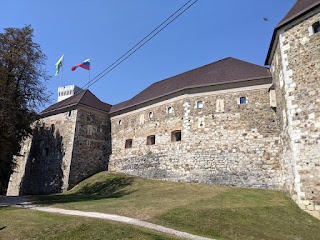 |
| Ljubljana Castle |
 |
| Ljubljana Castle |
 |
| Ljubljana from Ljubljana Castle |
 |
| Ljubljana from Ljubljana Castle |
We stopped for a cold beer and ice cream cone before joining the group and heading back to Bled. Once back in Bled, we drove up to the Bled Castle for a tour. The imposing 11th century Bled Castle, the oldest in Slovenia, is a medieval fortress, with huge towers, ramparts, moats and a terrace offering breathtaking views. After the tour, we had a Farewell Reception at Bled Castle with wine and appetizers.
 |
| Bled Castle Tour & Farewell Reception |
 |
| Bled Castle Tour & Farewell Reception |
 |
| Bled Castle Tour & Farewell Reception |
 |
| Bled Castle Tour & Farewell Reception |
 |
| Bled Castle Tour & Farewell Reception |
 |
| Bled Castle Tour & Farewell Reception |
 |
| Bled Castle Tour & Farewell Reception |
 |
| Bled Castle Tour & Farewell Reception |
 |
| Bled Castle Tour & Farewell Reception - Hotel in Center |
 |
| Bled Castle Tour & Farewell Reception |
 |
| Bled Castle Tour & Farewell Reception |
 |
| Bled Castle Tour & Farewell Reception |
 |
| Bled Castle Tour & Farewell Reception - Printing Room |
 |
| Bled Castle Tour & Farewell Reception |
 |
| Bled Castle Tour & Farewell Reception |
 |
| Bled Castle Tour & Farewell Reception - Men in Tour Group |
 |
| Bled Castle Tour & Farewell Reception - Women in Tour Group
|
After the farewell reception, we headed back to the hotel to pack our bags for the trip to Venice the following day.
Itinerary: Escorted tour ends. Morning transfer to Venice, Italy. Explore Venice on own.
Daily Journal
Weather: 78F, sunny and humid in Venice.
So the Gate1 tour of Albania, Montenegro, Croatia and Slovenia was officially over except for transferring most everyone to Venice. Most people on the tour returned to the US. Some stayed in Slovenia. We stayed in Venice for two days until flying to Palermo to catch our next Gate1 Tour of Sicily. The last time I was in Venice was 2020 when the Catholic church was celebrating its 2000-year anniversary.
 |
| Bled - I Love Lake Bled |
 |
Bled - So Long Lake Bled & Bled Castle
|
 |
| Dragon Tears (Plum Brandy) Souvenir from Our Tour Director |
After a hearty breakfast, the last of our group departed at 8:30 am by minivan for the 3-hour drive to the Venice International Airport. Around 10:30 am, we crossed the border into Italy where I expected to show off my negative COVID test result and vaccination card. But that didn't happen and we sailed right over the border without stopping. I wasn't sure whether this resulted from lax enforcement or whether our information had been forwarded to the border authorities ahead of time earning us a free pass.
Canal Ambulance:
Itinerary: Day to explore Venice on own.
Daily Journal
Weather: 78F and overcast.
We enjoyed a leisurely breakfast on the Grand Canal watching the boat traffic go by while preparing for another day of exploring Venice on our own.
 |
| Blue Line Shows Path We Walked Today |
Around 8:30 am, we set out to explore the Cannaregio area on the north side of the Grand Canal. It looked pretty much like the parts of Venice we saw the day before with lots of churches, public squares, shops, restaurants and canals.
By 11:30 am, we were done exploring and managed to get back to our hotel just before it started to rain. We checked into our Alitalia flight leaving the next day for Palermo.
 |
| Venice - Hotel in Center |
Around noon, we ventured back into the Santa Margherita area near our hotel and had coffee while watching the throngs of tourists and mostly students parading past in the rain.
After that, we walked back to the hotel and waited in the lobby while our room was being cleaned.
Later on, we walked back to Piazza San Marco and watched people for an hour. We took the water taxi back to our hotel at the Ferrovia stop. The trip took about 45 minutes, and even though I swore I was done taking pictures, I couldn't resist and took a lot of pictures since the views from the boat are like any other. A fitting way to end a trip to Venice.
 |
| Venice - Water Taxi Ride |
 |
Venice - Water Taxi Ride
|
 |
| Venice - Water Taxi Ride |
We went back to the Cannaregio pedestrian zone for dinner and enjoyed a really BIG liter beer with our seafood pasta dinner, followed by gelato for dessert.After that, it was back to the hotel to pack and get ready for the flight to Palermo tomorrow.
Itinerary: Fly to Palmero, Sicily to begin the second leg of this 22-day vacation. Explore Palermo on own.
Daily Journal
Weather: 91F and sunny in Palermo.
We got up early and checked out of our hotel ahead of schedule hoping to catch an earlier #35 ACTV bus from Piazzale Roma to the Venice International Airport. We stood in the rain at Pizzazale Roma waiting for the 7:15 am bus to arrive. At first, the driver would not let us switch from 8:15 am to 7:15 am, but then capitulated when he realized it didn't really matter since the 7:15 bus was far from full. Nice birthday present to me.
We arrived at the Venice airport around 7:45 am and spent several hours eating, sipping coffee, shopping and catching up on email.
Around 11:30 am, we departed Venice and arrived in Palermo following a short layover in Rome around 2:30 pm. The Gate1Travel agent met us in the arrival hall and drove us to our centrally-located hotel in the heart of Palermo. We had a few days on our own before the rest of the tour group arrived in two days. The blog for my time in Sicily can be found here: Chris Trost's 2021 Sicily Tour.












































































































































































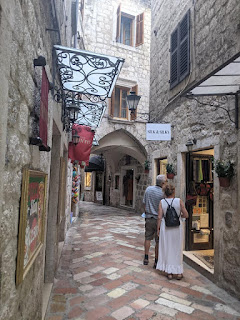














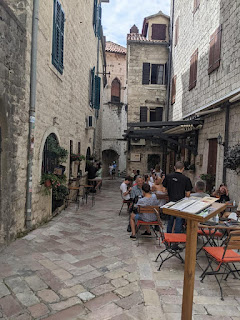








































































































































































































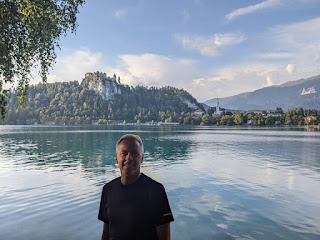




















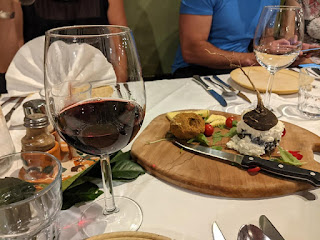











































































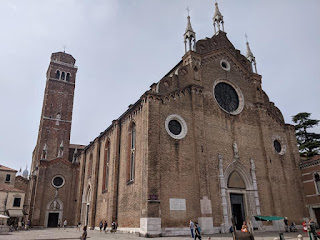







































































































No comments:
Post a Comment